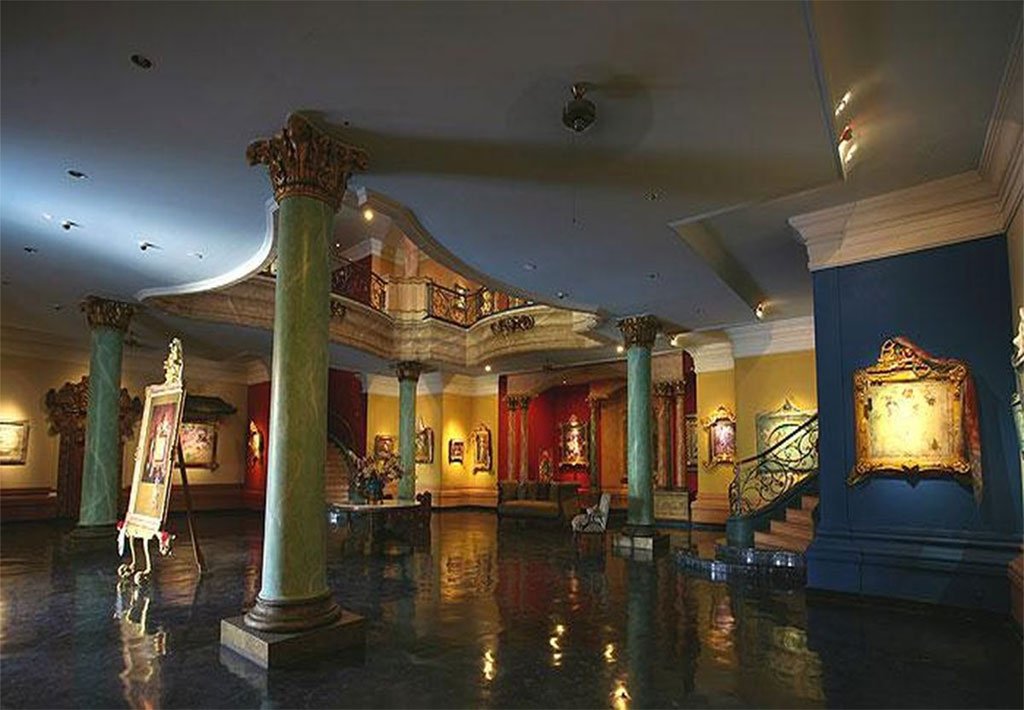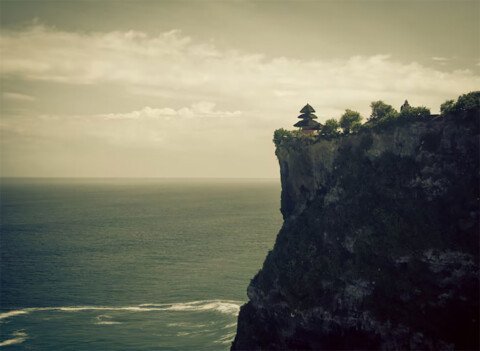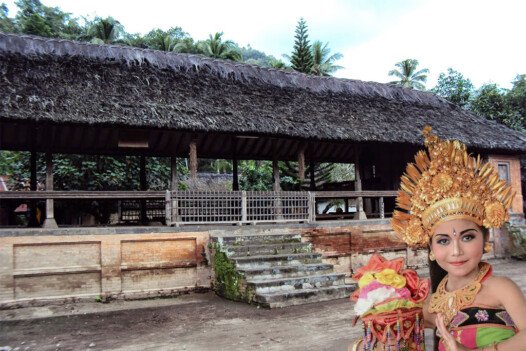Ubud—a name that conjures images of lush rice terraces, sacred temples, vibrant art galleries, and the aroma of incense drifting through morning air. Nestled in Bali’s central highlands, this cultural hub has long enchanted travelers, artists, and spiritual seekers.
More than just a destination, Ubud is a living tapestry: each street, each dance, each carved mask speaks to centuries of tradition, creativity, and devotion. In this exploration, we’ll journey through seven iconic cultural spaces in Ubud, unlocking stories that reveal Bali’s soul.
1. 🛕 Pura Saraswati: Temple of the Arts
Located at the northern entrance of central Ubud, Pura Saraswati is a jewel both in architecture and ambiance. Constructed in 1951 by the historic Ubud royal family and built around a lotus pond, this temple celebrates Saraswati, the Hindu goddess of knowledge, music, art, and wisdom.
As daylight dapples through frangipani trees, you’ll see locals offering daily canang sari—delicate palm-leaf baskets brimming with flowers, rice, and incense. Their chants swirl through the air, reflecting ancient rituals. At dusk, the temple hosts Legong dance performances—intricately choreographed and visually stunning, they portray mythological tales through precise hand gestures, dramatic costumes, and gilded masks.
Highlights:
- Immerse in nightly Balinese dance performances.
- Notice the lotus-filled pond reflective of serenity and creative spirit.
- Explore the surrounding galleries and souvenir stalls.
2. 🏛️ Blanco Renaissance Museum: A Singular Vision
Perched on the Campuhan ridge, the Blanco Renaissance Museum embodies the flamboyant spirit of its founder, Don Antonio Blanco, a Filipino–Spanish artist who made Ubud his creative haven. Opened to the public in 1998, the museum showcases Blanco’s flamboyant, expressive paintings, portraits of local beauties, and dramatic landscapes.
Inside, the villa’s architecture is a dizzying blend of Balinese and Spanish colonial styles—arched verandas, ornately carved ceilings, and mosaic embellishments. You’ll wander through lush garden terraces overlooking the Wos River gorge, framed by towering banyan trees.
Highlights:
- Bold, intimate artworks revealing Blanco’s love for Bali.
- An architecturally rich villa blending cultures.
- Tea terraces and scenic views perfect for contemplation.
3. 🎭 ARMA (Agung Rai Museum of Art): Where Tradition Meets Innovation
Founded in 1996, ARMA is more than just paintings—it’s an immersive encounter with living Balinese culture. The expansive campus showcases classical Balinese art, contemporary canvases, and regional masterpieces, all curated to stimulate dialogue between old and new.
Drawing from Bali’s rich performing-arts traditions, ARMA hosts Kris dance rituals, Gamelan workshops, and Kecak performances on its open-air theater stage. Every corner tells a different tale: Kamasan paintings echoing ancient myths, wayang-style shadow puppetry, avant-garde works questioning identity and modernity.
Highlights:
- Timeless and contemporary visual arts.
- Live theatrical and musical performances.
- Artist-in-residence programs and open studios.
4. 🌀 Puri Saren Royal Palace: A Legacy of Ubud Royalty
Though smaller than aristocratic palaces elsewhere, the Ubud Royal Palace—Puri Saren—the is culturally poignant. Built in the 1800s, it remains a symbol of royal patronage of the arts. Intricate wood carvings and stone reliefs grace gateways, revealing Hindu-Buddhist legends and ancestral lineage.
Daily, dancers in resplendent costumes perform court dances (Topeng, Legong, Balih-bali) on a raised courtyard stage. It’s free to enter, though performances may ask a modest donation. Wandering its halls, you get glimpses of regal elegance: polished wooden floors, antique furniture, tiled roofs, and framed photos of royal ceremonies.
Highlights:
- Authentic Balinese court dance performances.
- Historical architecture with carvings and ornate doors.
- A chance to absorb Ubud’s regal and artistic spirit.
5. 🌾 Tegallalang Rice Terrace & Subak Viewpoint: Sacred Farming Sculpture
Tegallalang’s cascading emerald terraces, just north of Ubud, aren’t simply picturesque—they’re a living monument to Bali’s subak—the ancient cooperative irrigation system recognized by UNESCO. Here, nature, geometry, and spirituality are one.
Walkers can follow bamboo-lined trails between fields; rice paddies ebb and flow with the monsoon, painting the land in vibrant tones of green and gold. You may glimpse local farmers guiding water channels, performing rituals to honor the spirits of the earth. Tea stalls tucked into terraces invite you to pause, reflect, and soak in the symphony of sun, soil, and community.
Highlights:
- Iconic views of tiered rice paddies sculpting the landscape.
- Insights into the traditional subak irrigation and spiritual customs.
- Refreshing local coffee or tea with panoramic views.
6. 🐍 Goa Gajah (Elephant Cave): Archaeology & Mysticism in Stone
Goa Gajah, around 5 km from Ubud, is an 11th-century sanctuary that fuses Hindu and Buddhist elements. Concealed in a cliffside, the carved caveface—snarling and dramatic—guards a temple once rivaling Java’s grandeur.
Descending stone steps, you pass bathing pools fed by ornate 11 fountains, each crowned with sacred imagery of gods and goddesses. Inside the cave, a dim chamber offers a sacred shrine, dim lanterns revealing carved reliefs of lingams, footprints, and mythical beings. The site’s troughs and aqueducts remind travellers of Bali’s enduring relationship with water rituals and purification rites.
Highlights:
- A dramatic carved cave facade with elephant-like features.
- Sacred bathing pools and flowing water elements.
- Quiet shrine rooms echoing centuries of spiritual devotion.
7. 🧘 Yoga Barn & Radiantly Alive: Centers of Mind‑Body‑Spirit
Modern spiritual tourism blooms in Ubud, but rooted in timeless traditions of healing and mindfulness. Two landmark wellness centers—The Yoga Barn and Radiantly Alive—have become global hubs for spiritual seekers and practitioners.
The Yoga Barn offers hundreds of classes weekly: hatha, vinyasa, yin, kundalini, prenatal, and aerial yoga. Also workshops on sound healing, Ayurveda, breathwork, mantra chanting, and inner alchemy. Healing rooms provide Ayurvedic therapies, massage, and energy medicine in serene wooden shalas.
Radiantly Alive emphasizes alignment, empowerment, and yoga teacher training. With rooftop studios, vibrant community events, farm-to-table vegetarian cafés, and seasonal retreats, it’s a microcosm of Ubud’s holistic pulse.
Highlights:
- Depth and variety in yoga, meditation, and holistic workshops.
- Schedules that appeal to both visitors and seasoned yogis.
- Communities rooted in self-discovery, connection, and cultural sensitivity.
Cultural Tapestry: Shared Themes Across the Spots
While each of these sites has its own identity, together they weave a narrative of Bali’s cultural essence:
- Sacred Ritual: Nearly every space involves devotion—whether offering, dance, temple worship, or oral storytelling.
- Artistic Innovation: Ubud is alive with painters, dancers, musicians, writers, and creators fusing tradition with innovation.
- Spiritual Ecology: Rice terraces and temples reflect sustainability not just in farming but in values of tattva (harmony) between humans and nature.
- Community Coherence: The subak system, daily temple ceremonies, healing circles, dance troupes—all pivot on cooperation and social unity.
Practical Tips: Maximizing Your Ubud Experience
| Tip |
Detail |
| Best time to visit |
Dry season (April to October). Morning performances and early temple visits to beat heat and crowds. |
| Dress code |
Respect sacred sites—shoulders and knees must be covered; sarong and sash often available onsite. |
| Performance planning |
Evening shows typically start 6–7 pm. Prebook tickets for Pura Saraswati or palace dances for guarantee. |
| Local guides |
Hiring a Balinese guide adds context—explanations of symbols, history, personal ancestral significance. |
| Support community |
Choose community-run galleries, workshops, and cafés. Purchase local crafts and support genuine artisans. |
| Mindful tip |
Ubud’s energy thrives on quality, awareness, and openness. Slowing down = deeper resonance. |
Conclusion: Carrying Ubud’s Magic With You
In Ubud, every stone-carved temple, rice paddy slope, museum corner, and yoga mat brims with stories. It’s a place where culture is not preserved behind glass, but lived—in dance, painting, water, breath, song, and silence. These seven cultural spots span time and medium, bridging ancient devotion and modern exploration. They remind us that Bali’s story isn’t static—it’s a craft we continue to weave.
Whether you come seeking artistic inspiration, healing energy, or immersive cultural exchange, allow Ubud’s magic to unfurl in your rhythm. Listen to whispers in temples, feel history beneath your feet, and carry a portion of Bali’s spirit along — transforming your own story in the process.









